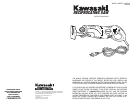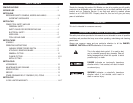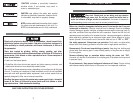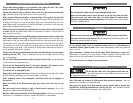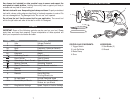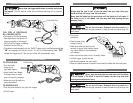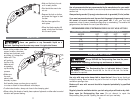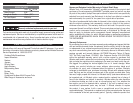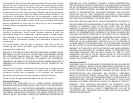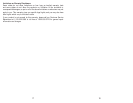
ACCESSORIES
Use only accessories that are recommended by the manufacturer for your model.
Accessories that may be suitable for one tool may become hazardous when used on
another tool.
Always attach grounded (3-prong) extension cords to grounded (3-hole) outlets.
If you must use an extension cord, be sure that the gauge is large enough to carry
the amount of current necessary for your power tool. If not, your tool may
experience a loss of power, excessive voltage drop or overheating. The smaller the
gauge number, the heavier the cord (see table below).
RECOMMENDED SIZES OF EXTENSION CORDS 120 VOLT AC 60 HZ TOOLS
TOOL CURRENT RATING CONDUCTOR SIZE IN A.W.G
AMPERE 10FT. 25FT. 50FT. 100FT.
3-6 18 18 18 18
6-8 18 18 18 16
8-10 18 18 18 14
10-12 16 16 14 14
12-16 14 12 12 -
16-20 12 12 12 -
MAINTENANCE AND CLEANING
Always UNPLUG the Reciprocating Saw from the power
source before inspecting, performing any maintenance or cleaning.
This Reciprocating Saw is lubricated before it leaves
the factory. This lubrication should last for the life of the tool. No further
lubrication is required.
Use only mild soap and a damp cloth to clean the tool. Never let any liquid get
inside the casing. Never immerse any part of the tool in a liquid. Always keep the
ventilation openings clear.
Brushes will wear with use and should be inspected periodically by qualified
personnel.
Regularly clean the ventilation slots in your tool using only a soft brush or dry cloth.
Never open the Reciprocating Saw case. Do not attempt to repair the
Reciprocating Saw yourself. Opening the case will void your warranty.
12
• Mark out the line to be cut
so it is easily visible.
• Start inside the area to be
cut out.
• Depress the lock-on button
and press the trigger to start
the saw.
• Set the shoe against the
work piece.
• When the blade reaches full
speed, slowly feed the blade
into the work piece.
METAL CUTTING
Never use gasoline or any flammable liquid as a
lubricant. Sparking from the motor may cause it to ignite into flames.
• When cutting metals other then
copper, brass or aluminum,
always use a lubricant, such
as cutting oil, to keep the
blade cool. This
will prolong
the life of the
blade as well
as speeding
up the cutting
process.
• Make sure
the work
piece is held
securely in place.
Hold smaller pieces, such as pipe or conduit,
in a vise or attach to the workbench with clamps.
• To eliminate vibration, always cut close to the clamping point.
• When cutting thin sheets of metal, place a piece of plywood on either side to control
vibration and prevent tearing.
11
OIL



